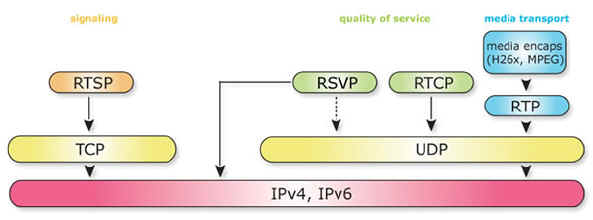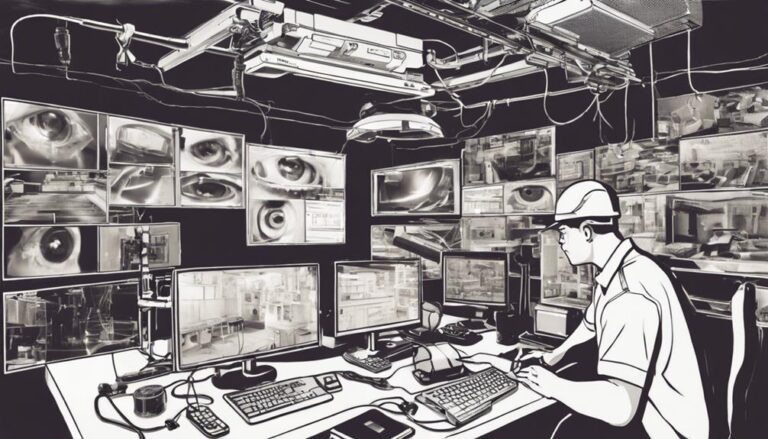RTSP and RTP are protocols for streaming media over networks. RTSP controls the streaming session, while RTP handles data transport.
RTSP (Real-Time Streaming Protocol) and RTP (Real-Time Transport Protocol) are essential for streaming multimedia content over the internet. RTSP serves as a network control protocol, managing the setup and control of streaming sessions between endpoints. It allows users to play, pause, and stop streams, ensuring smooth interaction.
RTP, on the other hand, focuses on delivering the actual media data efficiently. It transports audio and video data packets in real-time, ensuring minimal latency and high-quality transmission. Both protocols work together to provide seamless streaming experiences, making them indispensable in online media delivery.

Introduction To Rtsp And Rtp
The world of streaming often mentions two important terms: RTSP and RTP. These protocols are essential for delivering audio and video over networks. Understanding them helps in setting up and troubleshooting streaming services.
Defining Rtsp
RTSP stands for Real-Time Streaming Protocol. It controls streaming media servers. RTSP provides commands like play, pause, and stop. This makes it easier to manage the streaming sessions. It does not stream the media itself but controls it.
Think of RTSP as a remote control for your streaming service. It helps in navigating through the media content. The protocol works well with both live and stored media.
Defining Rtp
RTP stands for Real-Time Transport Protocol. It actually delivers the media streams. RTP works in tandem with RTSP. While RTSP controls, RTP transports the media data. It ensures the data packets reach the destination efficiently.
RTP can handle both audio and video streams. It uses sequence numbers and timestamps. These features help in synchronizing the media streams. RTP is crucial for real-time applications like video calls and live broadcasts.
| Feature | RTSP | RTP |
|---|---|---|
| Full Form | Real-Time Streaming Protocol | Real-Time Transport Protocol |
| Primary Function | Control streaming media servers | Transport media streams |
| Role | Manages commands like play, pause, stop | Ensures data packets reach the destination |
| Usage | Remote control for streaming services | Handles audio and video streams |

Core Functions
Understanding the core functions of RTSP and RTP helps in grasping their distinct roles. RTSP (Real-Time Streaming Protocol) and RTP (Real-Time Transport Protocol) are essential in streaming media over networks.
Rtsp Functionalities
RTSP is a network control protocol. It manages streaming media servers and provides clients with remote control of the media stream. Here are some key functionalities of RTSP:
- Setup: Establishes a connection for media streaming.
- Play: Starts the media stream.
- Pause: Temporarily stops the media stream.
- Teardown: Ends the media session.
RTSP allows users to play, pause, and stop media streams. It operates similarly to a TV remote control. RTSP is not responsible for the actual delivery of data.
Rtp Functionalities
RTP handles the actual delivery of media data. It is used in conjunction with RTSP for streaming. Key functionalities of RTP include:
- Packetization: Splits media data into packets.
- Sequencing: Ensures packets are in the correct order.
- Timestamping: Synchronizes media streams.
- Payload Identification: Identifies the type of data carried.
RTP ensures that media data is delivered in real-time. It handles the timing and sequence of media packets. RTP works with RTSP to stream media smoothly.
| Functionality | RTSP | RTP |
|---|---|---|
| Control | Yes | No |
| Media Delivery | No | Yes |
| Packetization | No | Yes |
| Sequencing | No | Yes |
How They Work
Understanding how RTSP and RTP work can be quite insightful. Both protocols play pivotal roles in streaming media. They handle different tasks in the delivery of streaming content. Below, we will explore their workflows.
Rtsp Workflow
The Real-Time Streaming Protocol (RTSP) manages the streaming sessions. It controls the delivery of multimedia. Here’s how it works:
- Client Request: The client sends a request to the server.
- Server Response: The server responds with a description of the media.
- Client Setup: The client sets up a session based on the response.
- Streaming Control: The client can play, pause, or stop the media.
RTSP uses commands like PLAY, PAUSE, and TEARDOWN. These control the streaming session. The protocol ensures smooth communication between client and server.
Rtp Workflow
The Real-Time Transport Protocol (RTP) handles the actual data transfer. It delivers the media content to the client. Here’s a breakdown:
- Packetization: The server breaks the media into smaller packets.
- Transmission: RTP packets are sent over the network.
- Reception: The client receives the RTP packets.
- Reassembly: The client reassembles the packets into the original media.
RTP uses timestamps and sequence numbers. These ensure the correct order and timing of the packets. This protocol is crucial for maintaining media quality.
Together, RTSP and RTP make media streaming efficient and reliable. They complement each other to provide a seamless streaming experience.
Protocol Differences
Understanding the differences between RTSP and RTP is crucial. These protocols serve different purposes in streaming media. Knowing their distinctions helps in choosing the right protocol for your needs.
Control Vs Transport
RTSP (Real-Time Streaming Protocol) primarily handles the control aspect of streaming. It allows clients to issue commands. These commands include play, pause, and stop. Think of RTSP as the remote control of your media player.
RTP (Real-Time Transport Protocol), on the other hand, is responsible for the actual transport of data. RTP ensures that the media data gets from the server to the client efficiently. It deals with the real-time delivery of audio and video streams.
| Protocol | Function |
|---|---|
| RTSP | Control |
| RTP | Transport |
Connection Requirements
RTSP uses TCP (Transmission Control Protocol) for connection establishment. TCP ensures a reliable connection. It guarantees that control commands reach their destination without errors.
RTP generally uses UDP (User Datagram Protocol). UDP is faster but less reliable than TCP. It is suitable for real-time data where speed is crucial. RTP can also work over TCP if needed.
- RTSP: Uses TCP
- RTP: Uses UDP, can use TCP
Common Use Cases
Understanding the common uses of RTSP and RTP is crucial. These protocols are widely used in various applications. Each has unique strengths and specific use cases.
Rtsp Applications
RTSP is known for managing and controlling streaming media. It is often used in:
- IP Cameras: RTSP helps in viewing and controlling IP cameras remotely.
- Video On Demand: It allows users to pause, play, and seek videos.
- Live Streaming: RTSP is used for real-time video and audio streaming.
RTSP provides efficient control over media streams. This makes it ideal for interactive applications.
Rtp Applications
RTP excels in delivering audio and video over IP networks. It is commonly used in:
- VoIP: RTP is essential for transmitting voice over IP networks.
- Video Conferencing: Ensures synchronized audio and video for clear communication.
- Streaming Services: Used in platforms like YouTube for live streaming.
RTP focuses on real-time data transmission. This ensures low latency and high-quality streams.
| Protocol | Application |
|---|---|
| RTSP | IP Cameras, Video On Demand, Live Streaming |
| RTP | VoIP, Video Conferencing, Streaming Services |

Performance Considerations
Understanding the performance of RTSP and RTP is crucial. These protocols play key roles in streaming media. Each protocol has its own strengths and weaknesses. Let’s explore their efficiency.
Rtsp Efficiency
RTSP stands for Real-Time Streaming Protocol. It controls streaming media servers. RTSP handles setup, teardown, and control of media streams. It operates at the application layer.
RTSP is responsible for session management. It allows clients to pause, resume, or stop streams. This flexibility makes RTSP ideal for interactive applications. Efficient session management reduces network congestion. This improves overall streaming performance.
Rtp Efficiency
RTP stands for Real-Time Transport Protocol. It delivers audio and video over IP networks. RTP works alongside RTSP but focuses on data transport. It operates at the transport layer.
RTP ensures timely delivery of media data. It includes mechanisms for packet sequencing and timestamping. This ensures synchronized playback of audio and video streams. RTP’s efficiency lies in its low latency and high reliability.
| Feature | RTSP | RTP |
|---|---|---|
| Role | Session Management | Media Data Transport |
| Layer | Application | Transport |
| Flexibility | High | Medium |
| Latency | Medium | Low |
| Reliability | Moderate | High |
Security Aspects
When comparing RTSP and RTP, security is crucial. Both protocols have unique security features. Let’s explore how each one handles security.
Rtsp Security Features
RTSP stands for Real-Time Streaming Protocol. It focuses on controlling streaming media. To ensure security, RTSP uses several methods:
- Encryption: RTSP can use TLS (Transport Layer Security) for encryption.
- Authentication: RTSP supports Digest Authentication. This ensures only authorized users can access the stream.
- Access Control: RTSP servers can restrict IP addresses. This prevents unauthorized access.
These features help keep your streaming media secure.
Rtp Security Features
RTP stands for Real-Time Protocol. It handles the delivery of audio and video. For security, RTP offers:
- SRTP: Secure RTP (SRTP) provides encryption for RTP streams.
- Authentication: SRTP ensures data integrity. It checks if the data is tampered with.
- Replay Protection: SRTP prevents replay attacks. It uses sequence numbers to track packets.
RTP’s security features aim to protect data during transmission.
Below is a table summarizing the key security features of RTSP and RTP:
| Feature | RTSP | RTP |
|---|---|---|
| Encryption | TLS | SRTP |
| Authentication | Digest Authentication | SRTP Authentication |
| Replay Protection | Not Available | Available |
| Access Control | IP Restriction | Not Available |
Both protocols offer robust security features. Choosing the right one depends on your needs.
Choosing The Right Protocol
When streaming video, choosing the right protocol is crucial. RTSP (Real-Time Streaming Protocol) and RTP (Real-Time Transport Protocol) are popular choices. Both have unique advantages and disadvantages. Understanding your needs helps in making the right decision.
Factors To Consider
- Latency: RTSP generally offers lower latency than RTP.
- Compatibility: RTP is widely supported across various platforms.
- Security: RTSP has built-in security features.
- Bandwidth: RTP can be more bandwidth-efficient.
- Scalability: RTSP is better for large-scale deployments.
Best Practices
Here are some best practices to follow:
- Evaluate your network: Check if your network supports the chosen protocol.
- Test both protocols: Perform tests to compare latency and quality.
- Consider security needs: Choose RTSP for enhanced security features.
- Optimize bandwidth: Ensure your network can handle the bandwidth requirements.
- Plan for scalability: If needed, choose RTSP for better scalability.
Both RTSP and RTP have their own benefits. Carefully consider your specific needs to choose the best protocol for your streaming solution.
Future Trends
The landscape of streaming protocols is ever-changing. With advancements in technology, both RTSP and RTP are evolving. Future trends in these protocols will shape the way we consume media.
Evolving Rtsp
RTSP is adapting to new demands. Enhanced security features are being integrated. These include stronger encryption and better authentication methods.
Interoperability is another focus area. Future RTSP versions aim to support a wider range of devices. This includes smart TVs, smartphones, and IoT devices.
Low-latency streaming is also a key trend. Innovations are reducing delays, making real-time streaming more efficient. This is crucial for applications like live sports and online gaming.
Here’s a quick look at some of the evolving features of RTSP:
- Stronger encryption
- Better authentication
- Wider device support
- Low-latency streaming
Evolving Rtp
RTP is also undergoing significant changes. Adaptive bitrate streaming is becoming more common. This allows for better quality video, even with varying network conditions.
Improved error correction mechanisms are being introduced. These aim to minimize data loss and enhance the viewing experience.
Integration with AI is another exciting trend. AI can optimize streaming by predicting and adjusting to network conditions in real-time.
Here are some of the key evolving features of RTP:
- Adaptive bitrate streaming
- Improved error correction
- AI integration
Both RTSP and RTP are adapting to meet the needs of modern streaming. These advancements will shape the future of media consumption.
Frequently Asked Questions
What Is Rtsp Used For?
RTSP is used to control streaming media servers. It helps manage real-time streaming of audio and video.
What Does Rtp Stand For?
RTP stands for Real-time Transport Protocol. It is used for delivering audio and video over IP networks.
How Do Rtsp And Rtp Differ?
RTSP controls streaming sessions, while RTP delivers the actual media content. They often work together.
Can Rtsp And Rtp Work Together?
Yes, RTSP and RTP frequently work together. RTSP manages the session, and RTP delivers the media.
Conclusion
Choosing between RTSP and RTP depends on your specific streaming needs. RTSP offers control over streaming, while RTP provides real-time delivery. Both protocols have their unique advantages. Understanding their differences helps you make an informed decision. Optimize your streaming experience by selecting the right protocol for your application.


